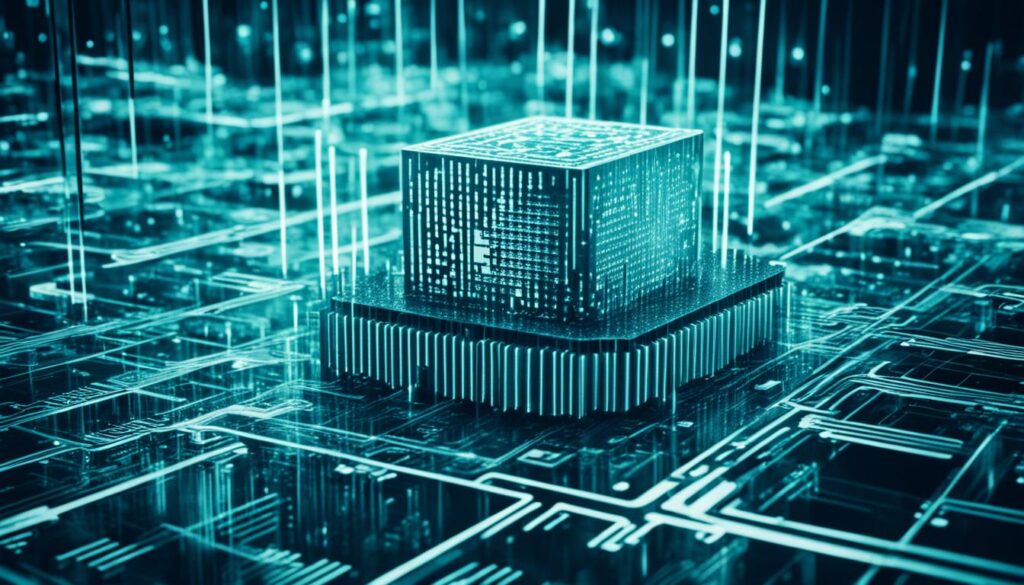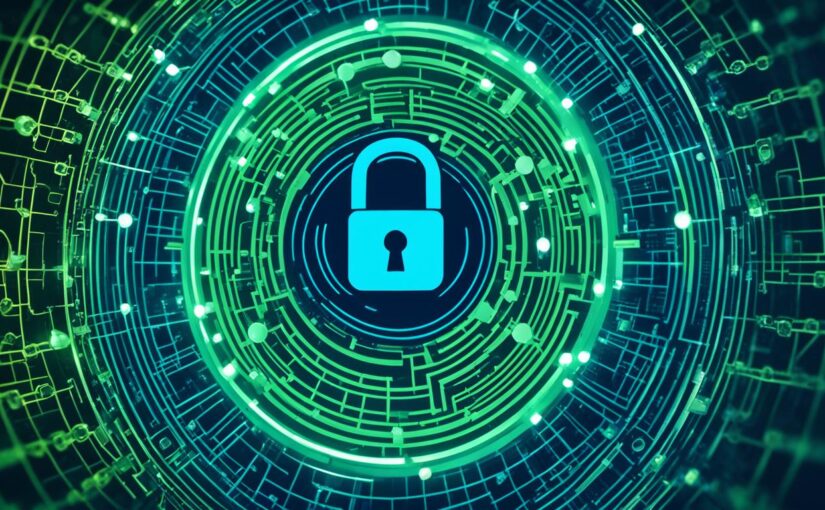As the digital landscape continuously evolves, so does the need for impenetrable security within the blockchain ecosystem. With the burgeoning adoption of this technology across various industries, safeguarding blockchain transactions has surfaced as a paramount concern for corporations and individuals alike. The integration of rigorous blockchain cybersecurity solutions is not only prudent but obligatory, as it becomes our bulwark against the sophisticated and often imperceptible maneuvers of cyber adversaries. In the forefront of guarding these digital ledgers, preventing blockchain hacks is not just a necessity, it’s an ongoing struggle to preserve the integrity of decentralized transactions.
Key Takeaways
- Importance of robust security in blockchain’s evolving adoption
- Crucial role of cybersecurity solutions in protecting assets
- Proactive tactics for preventing blockchain hacks
- Strategic significance of transaction safeguarding in the blockchain
- Persistent vigilance as a keystone in blockchain security
Understanding the Importance of Blockchain Security
The digital age has ushered in a new frontier for financial transactions, with blockchain technology at the forefront of this revolution. Its promise of decentralization and immutability make it an alluring option for various applications, from cryptocurrencies to supply chain management. However, the inherent properties that make blockchain technology so valuable also expose it to a unique set of vulnerabilities. As businesses and individuals increasingly adopt this technology, understanding and enhancing blockchain security must be a top priority.
Ensuring the integrity of blockchain networks is not merely a recommendation but a necessity to ward off the potential impacts of security incidents—financial losses, reputational damage, and trust erosion are at stake. Effective blockchain security measures play a critical role in securing blockchain technology against both the known and the yet-unknown threats that are evolving in the digital ecosystem.
Here’s a closer look at the crucial elements that underline the importance of robust blockchain security:
- The authentication of participants to prevent unauthorized access.
- Mitigation of risks associated with smart contract vulnerabilities.
- Protection against the 51% attack, where a user or a group gains control over the majority of the network’s mining power.
- Ensuring data privacy while upholding the transparent nature inherent to blockchain systems.
- Continual monitoring and updating of security protocols to keep ahead of threat actors.
The following table showcases the spectrum of potential threats to blockchain technology and why bolstering security is indispensable:
| Type of Threat |
Description |
Consequences of Breach |
| 51% Attacks |
An attacker gains majority control of a blockchain’s computing power, allowing them to double-spend coins and halt new transactions from gaining confirmations. |
Disrupt network integrity, diminish trust among users, and incur significant financial losses. |
| Code Vulnerabilities |
Flaws in smart contracts or the blockchain protocol itself can be exploited by hackers to breach the network. |
Lead to theft of digital assets, manipulation of contracts, and destabilization of the entire blockchain ecosystem. |
| End-Point Security Risks |
User devices and Internet connectivity points can be targeted to gain unauthorized access to wallet keys and personal data. |
Result in asset theft and unauthorized transactions, compromising personal and financial information. |
| Sybil Attacks |
Creation of a large number of pseudonymous identities to gain a disproportionately massive influence on the network. |
Undermine network stability and consensus mechanisms, hindering normal operation of the blockchain. |
As the landscape of securing blockchain technology grows more complex, the impetus to develop and adopt effective strategies for enhancing blockchain security will grow in parallel. Stakeholders must prioritize these security measures to preserve the integrity and trustworthiness that blockchain offers. Doing so will safeguard the revolutionary potential of this technology for future innovations and applications.
Strategies for Fortifying Blockchain Infrastructure
As blockchain technology continues to revolutionize the digital world, the urgency for implementing robust security measures is at an all-time high. Businesses adopting blockchain must be vigilant, employing a multifaceted approach to protect against breaches and maintain trust in their networks. Let’s delve into the strategic measures that are imperative for securing blockchain systems.
Integrating Robust Blockchain Security Protocols
Protecting blockchain networks starts with the foundational step of integrating advanced security protocols. These protocols are the first line of defense against unauthorized access and potential breaches. Emphasizing on blockchain’s inherent strength, they leverage cryptographic algorithms and consensus methodologies to ensure data integrity and authentication.

Regular Security Audits and Vulnerability Assessments
To ensure continued efficacy in blockchain security measures, it’s essential to conduct regular security audits. These assessments reveal the health of the network by identifying any potential vulnerabilities before they can be exploited.
| Audit Component |
Purpose |
Outcome |
| Penetration Testing |
To simulate attacks on the system to identify weaknesses |
Enhanced system resilience |
| Code Review |
To meticulously examine the code that runs the blockchain |
Identification of code-based vulnerabilities |
| Compliance Check |
To ensure adherence to legal and security standards |
Alignment with industry best practices |
Implementing Access Management Controls
At the heart of safeguarding blockchain systems is the need to control who can access what within the network. Implementing stringent access controls can prevent unauthorized entry and limit the impact of any potential security incidents. These controls often include multi-factor authentication and comprehensive permissions frameworks, crucial for protecting blockchain networks.
- User Authentication
- Permissions and Roles
- Audit Trails for Access
In conclusion, blockchain security is not a one-off event but a continuous process. By incorporating strong security protocols, conducting regular audits, and managing access with care, organizations ensure the fortification of their blockchain infrastructures against the ever-evolving landscape of digital threats.
Blockchain Security Measures
In the ever-evolving landscape of blockchain technology, the implementation of robust security measures is not just a recommendation, but an imperative. As the digital domain continues to expand, safeguarding blockchain transactions with state-of-the-art security protocols ensures the integrity and confidentiality of digital assets.
Advanced Blockchain Encryption Techniques
One of the most critical components of blockchain security is the use of advanced encryption techniques. These sophisticated algorithms encode data, making it virtually impenetrable to unauthorized access. Encryption serves as the first line of defense in protecting the confidentiality of blockchain transactions, utilizing cryptographic keys to maintain a secure environment. Below is an overview of the encryption techniques vital for blockchain security:
- Public Key Cryptography: A method that uses a pair of keys – a public key that’s shared and a private key that’s kept secret – to ensure secure transactions.
- Symmetric Encryption: This technique involves a single key for both encryption and decryption processes, facilitating faster transaction verifications.
- Hash Functions: By producing a unique digital fingerprint of data, hash functions validate the integrity and authenticity of transactions on the blockchain.
Employing Multi-Signature Authentication
Enhancing security measures further, multi-signature authentication requires more than one key to authorize a blockchain transaction. This protocol adds an additional layer of security, making it significantly more challenging for unauthorized entities to manipulate the ledger. Multi-signature authentication plays a pivotal role in:
- Preventing single points of failure, decentralizing trust among multiple parties.
- Providing enhanced control over assets, as transactions need multiple verifications.
- Enabling more complex security arrangements for institutional and enterprise blockchain applications.
Securing End-Point Devices
The final step in the trifecta of blockchain security is ensuring the integrity of end-point devices. End-point device security is often overlooked, yet it is crucial in maintaining a secure blockchain ecosystem. These security measures protect device access points from being exploited by cyber threats. Effective strategies include:
- Implementing hardware security modules (HSM) to manage digital keys and perform encryption and decryption functions directly on the device.
- Running up-to-date antivirus software to combat malware and other threats.
- Conducting regular security training and awareness programs to minimize the risk of human error.
Incorporating these blockchain security measures, with a focus on encryption techniques and security protocols, is essential for anyone operating within the blockchain space. As the technology matures, so too must the strategies we employ to protect our digital assets and secure the blockchain infrastructure against evolving threats.
Protecting Your Blockchain Assets Against Cyber Threats
The ever-evolving realm of blockchain technology necessitates astute strategies for securing digital assets on blockchain. Individuals hold the power to enhance their digital asset security substantially through a series of rigorous practices. Let’s delve into the best practices for keeping cyber threats at bay.

One of the essential tools in an individual’s arsenal is the hardware wallet. Unlike software wallets, which are prone to cyber-attacks, hardware wallets store private keys offline, providing an added layer of security.
Beyond hardware solutions, software updates form the frontline defense against vulnerabilities. Regularly updating blockchain wallet software ensures that protection against newly discovered threats is in place.
- Utilize Hardware Wallets for added security
- Keep Software and Firmware Updated
- Be Vigilant of Phishing Attempts
- Use Strong, Unique Passwords for Accounts
- Enable Two-Factor Authentication (2FA)
It’s equally crucial to stay informed about the landscape of cyber threats. Phishing attacks, for instance, are common yet preventable with the right knowledge. Keeping abreast with security trends and best practices can safeguard one’s blockchain assets with much-needed resilience.
In conclusion, the responsibility of securing digital assets on blockchain lies with individuals as much as it does with institutions. By employing robust tools and staying vigilant, users can play a pivotal role in sidestepping the ever-looming specter of cyber threats.
Enhancing Blockchain Security Through Best Practices
The digital age has ushered in an era where blockchain security measures are not just an option but a necessity. As we continue to integrate blockchain technologies into various sectors, the onus is on the global community to adopt and promote practices that are instrumental in protecting blockchain networks. This collaborative effort is critical in ensuring the safeguarding of digital assets against an ever-evolving landscape of cyber threats.
One of the key aspects of enhancing blockchain security revolves around the incorporation of advanced technologies destined for timely threat detection and resolution. From machine learning algorithms to quantum-resistant cryptography, these cutting-edge innovations are equipping blockchain networks with formidable tools to repel cyber assaults.
- Implementation of real-time threat detection systems
- Deployment of AI-driven security protocols
- Upgradation to quantum-resistant cryptographic methods
However, technology alone is not a panacea. The education and continuous training of users and blockchain professionals stand out as pivotal factors in the crusade against digital piracy and frauds. An informed community is the first line of defense against potential security breaches.
“The future of blockchain security lies in the hands of those who use it. Collective vigilance and informed practices are key to strengthening our digital fortresses.” – Expert in blockchain technology
In light of this, below is a tabular representation depicting essential user-centric practices that contribute significantly to the security of blockchain networks:
| User Practice |
Purpose |
| Multifactor authentication |
Adds layers of security beyond single-password protection |
| Regularly updated wallets and software |
Ensures protection against newly discovered vulnerabilities |
| Keen scrutiny of smart contracts |
Prevents exploitation of coding flaws |
| Participation in security awareness training |
Equips users with knowledge to identify and thwart phishing attempts |
In conclusion, securing blockchain technology is a dynamic and ongoing process that demands active and informed participation from everyone involved. Stakeholders must not only embrace innovative security measures but also foster a culture of security consciousness to ensure the integrity and longevity of blockchain networks.
Enhancing Blockchain Security Through Best Practices





